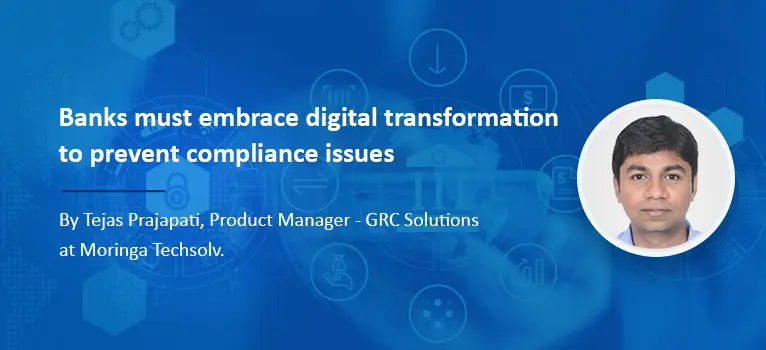
Banks must embrace digital transformation to prevent compliance issues
Last month, the Reserve Bank of India imposed a penalty on two mid-sized urban cooperative banks owing to violation of norms related to income recognition, asset classification, and provisioning. The same month also saw Income Tax Department’s directive to freeze deposits worth over half a billion rupees of an urban credit cooperative bank in Maharashtra. The reason for the seizure was the ‘glaring irregularities’ in the opening of accounts. Similarly, severe restrictions were imposed on another urban cooperative bank in Maharashtra including Rs 1,000 cap on withdrawals for customers. In 2020 alone, the banking sector regulator had directed the closure of three cooperative banks and issued 106 directives. Not only cooperative banks, many commercial banks & NBFCs also had to face penal actions from RBI due to contraventions of norms every year. India’s largest bank State Bank of India has imposed a penalty of one crore rupees in October this year on violation of rules pertaining to frauds classification and reporting. So, the list is long. And contrast to popular perceptions, such contraventions didn’t arise due to malicious intent in most of the cases. Rather, lack of supervision and absence in the deployment of the right technological solutions seem to be the key reasons.
According to global consultancy firm PwC, lenders in India on an aggregate basis spend between 1.5 and 2 per cent of their annual revenues on technology, compared with a range of between 7 to 10 per cent by global banks. The frequency of outages, flaws in complying with KYC (Know Your Customer) and AML (anti-money laundering) norms, and faulty credit monitoring process point to this aspect.
Banking is changing very fast:
Banking in India has been changing rapidly. Digital banking is emerging as the new face of banking. A FIS Survey report of September 2020 found that India has seen a surge in digital payments amidst the COVID-19 pandemic. According to the survey, around 68 per cent of Indians were using online or mobile banking to conduct financial transactions, and 51 per cent expected to continue using these banking and payment methods after the pandemic. Transactions through Unified Payments Interface (UPI) touched an all-time high of Rs 6.50 lakh crore (approximately US$88 billion) in September 2021, more than 80 times compared to five years ago. Financial inclusion programme like Jan Dhan Yojana led to the opening of 44 crore accounts so far in the country. These statistics reveal that the Indian economy is formalizing at a faster rate than expected. Such formalization increases the number of banking transactions in the system, putting more load on banks’ IT infrastructure.
Moreover, India has a greater number of young population flocking into the banking system each day. This set of customers demand user-friendly digital interfaces, prompt responses along faster services delivery. To cater to these customers efficiently, the digital transformation of banks holds the key. Meanwhile, the startup ecosystem is burgeoning in India with a number of fintechs in digital wallets, digital payments, and digital lending emerging each passing day. Banks need a robust IT system to withstand competition from these new-age players. Along with rising user base, regulatory scrutiny is also increasing and becoming more complex.
Technology is the only panacea:
A higher number of customers with a high volume of transactions pose its own set of challenges concerning KYC, AML, risk management, credit monitoring, NPA management, and recovery among others. Therefore, the legacy hardware and software used by banks, which have been around for decades, need to be in sync with the present-day requirement. Such digital transformation revolves around rebuilding the operations, customer interfaces, and procedures. And this transformation is powered through leveraging various digital technologies such as AI, ML, IoT, data analytics, blockchain, cloud computing, and many more. For instance, many operations of banks are being automated through robotic process automation. From account opening to credit eligibility are being processed through RPA nowadays. This not only restricts the flaws that can arise due to oversight but also reduces the element of subjectivity. Similarly, AI-powered apps give seamless customers experience on the front end and are able to draw powerful insights on customer behaviour for customised service offerings. Similarly, various SaaS-based software solutions can be integrated with the core banking platforms, that will help banks better insights for audit, compliance, loan monitoring, NPA management, and anti-money laundering operations. These SaaS solutions are powered through data analytics, AI, and ML that generate powerful algorithm, which helps financial institutions to detect anomalies beforehand.
Technological interventions not only make processes efficient but also provide a lot of cost savings to financial institutions with zero compliance risks. As SaaS solutions come with a subscription-based revenue model, financial institutions can deploy cutting-edge technology solutions at minimal upfront cost.
As digital banking becomes the norm, a Gartner CIO Survey identifies that AI and ML as the number one game-changing technology followed by data analytics. However, deployment of these digital technologies with the legacy system requires a sound technology partner for seamless integration with minimal downtime. Tomorrow’s winners in financial services space will be those who embrace digital transformation faster at all levels.
Moringa Techsolv enables financial institutions to reduce risk through embracing cutting-edge technology solutions
We at Moringa Techsolv provide CladRysk® suite of governance solutions to BFSI clients globally. ‘CladRysk®’ portfolio offers a comprehensive range of solutions catering to areas including audit, compliance & risk management, Anti-Money Laundering & KYC, credit administration, monitoring & Non-Performing Asset Management among others to BFSI clients.
Compatible with both public and private cloud environment, Moringa’s licensed and SaaS solutions easily integrate with the bank’s core banking platform or various APIs in use with no downtime risks. Through advanced data analytics applications, our solutions flag up anomalies or suspicious transactions on real time basis. In turn, banks can take remedial measures well in advance, mitigating compliance risks. With attractive subscription-based revenue model, financial institutions also get a high return on their investments with Moringa onboard.
By Tejas Prajapati
Product Manager - GRC Solutions at Moringa Techsolv
RECENT POSTS
TAGS
- compliance
- digital banking
- BFSI
- AML
- KYC
- regtech
- risk management
- SaaS
- UPI
- RBI
- Cooperative banks
- Jan Dhan Yojana
- NPA management
- CladRysk®
- AI
- ML
- FSI

